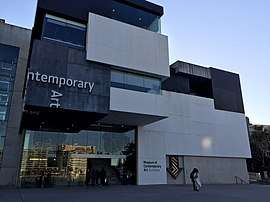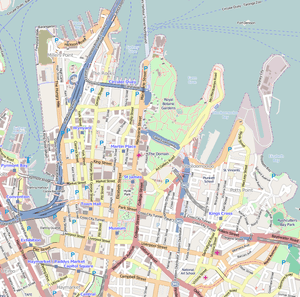Museum of Contemporary Art Australia
The Museum of Contemporary Art Australia (abbreviated MCA), located in George Street, Sydney, is an Australian museum solely dedicated to exhibiting, interpreting and collecting contemporary art, both from across Australia and around the world. It is housed in the art deco-style[3] former Maritime Services Board Building on the western edge of Circular Quay.
 | |
 Location in Sydney central business district | |
| Established | 1991 |
|---|---|
| Location | George Street, Sydney, Australia |
| Coordinates | 33°51′36″S 151°12′32″E |
| Type | Contemporary art |
| Visitors | 1,206,243 (2016)[2] |
| Founder | John Power; University of Sydney |
| Director | Elizabeth Ann Macgregor |
| Chairperson | Simon Mordant |
| Public transit access | |
| Website | mca |
The museum was opened in 1991 as the Museum of Contemporary Art, Sydney, and from 2010 underwent an A$58 million expansion and re-development,[4] reopening on 29 March 2012 under its current name as the Museum of Contemporary Art Australia.[5][6] The collection contains over 4,000 works by Australian artists that have been acquired since 1989. The collection spans all art forms with strong holdings in painting, photography, sculpture, works on paper and moving image, as well as significant representation of works by Aboriginal and Torres Strait Islander artists.
History

The establishment of the MCA was mandated in the will of Australian expatriate artist JW Power (1881–1943), who bequeathed his personal fortune to the University of Sydney with the express purpose of informing and educating Australians in the contemporary visual arts.
In December 1970 the University of Sydney also received the Seymour Bequest for the purposes of a performing arts centre, and sought to combine the two bequests into an arts complex that would include within it the Seymour Centre and the Power Institute facilities, including a home for the Power Gallery. [7][8] The Seymour centre was opened in 1975 without designs for the Power Institute of Fine Arts being integrated into the final building.
This collection of artworks thus took the form of the ‘Power Gallery of Contemporary Art’, a travelling collection of artworks without a permanent address. Between John Power’s death and the eventual establishment of the museum as we know it today, the collection was mainly housed in the University of Sydney. They were stored in the University’s Fisher Library during the 1970s. The collection functioned as an exhibition within the Madsen Building on campus between 1980 and 1989.[8]
With the relocation of the Maritime Services Board (MSB) from the 1949 built five-storey building to larger premises in 1989, the building and site was donated by the Government of New South Wales to the Museum of Contemporary Art.[9] Funded by the University of Sydney and the Power Bequest, restoration and refurbishment of the building commenced in 1990 under the direction of Andrew Anderson of Peddle Thorpe/John Holland Interiors and in November 1991 the Museum of Contemporary Art officially opened.
Extensions made in 2010–2012 were to a design by Sydney architect Sam Marshall. The new extension, called the Mordant Wing, opened in March 2012.[10][11] The wing was named after the chairperson of the museum’s board, Simon Mordant. The role of chairperson is expected to be taken over by Lorraine Tarabay in July 2020.[12]
The MCA is a not-for-profit, charitable organisation which receives ongoing funding and support from the NSW State Government through Arts NSW and the Commonwealth Government through the Australia Council. Every year, the MCA raises approximately 70% of its income from a variety of sources such as exhibitions and events, sponsorship, donations and venue hire.[13]
Architecture
The museum comprises two wings, the main section housed in the former Maritime Services Board (MSB) building, and the newer Mordant Wing on the museum's Northern end opened in 2012.
.jpg)
The architecture of the Museum of Contemporary Art has drawn both criticism and praise from both Australian and international commentators, mainly directed towards the buildings' contrasting facades. [14][15] The former MSB building is six floors of brick and concrete with an Art Deco exterior. The building’s former offices were renovated into a more open space with movable walls to accommodate exhibition requirements, with some rooms left intact as archival spaces. The building itself is heritage listed both within NSW and federally.[16]
The design of the Mordant Wing is by Sydney-based architect Sam Marshall who began planning the extension in 2001, after designs by Japanese and German architectural firms were ultimately rejected in 1997 and 2001 respectively. [14]
The Mordant Wing is a more contemporary design inspired by cubism, its facade consisting of overlapping black and white boxes with large angular windows. The Mordant wing includes a range of facilities including a library, classrooms, and a rooftop sculpture terrace with views of the harbour. The extension also created dedicated spaces within the building to exhibit video art.
Collections
What is now the museum’s main collection emerged from the Power Collection in the original founding of the museum.
The museum’s initial acquisitions policy, based on the will of John Power, sought to acquire mainly international contemporary art whilst only “very occasionally” purchasing Australian art as complementary to its foreign collection.[17] From 2002, the museum has shifted to increase its emphasis on Australian artists and currently holds over 4500 works. [18]
_Yoko_Ono'_exhibition_-_Sydney%2C_Museum_of_Contemporary_Art_Australia_(10867844565).jpg)
Selected Temporary Exhibitions
- Pipilotti Rist - ‘Sip My Ocean’ (2018)
- Grayson Perry - ‘My Pretty Little Art Career’ (2016)
- Yoko Ono - ‘War is Over! (if you want it)’ (2013)
- Anish Kapoor (2013)
- Annie Leibovitz - ‘A Photographer’s Life 1990-2005’ (2011)
- Yayoi Kusama - ‘Mirrored Years’ (2009)
- Patricia Piccinini - ‘Call of the Wild’ (2002)
- Cindy Sherman - ‘Retrospective’ (1999)
- Marina Abramović - ‘objects, performance, video, sound’ (1998)
- Keith Haring (1996)
- Andy Warhol - ‘Portraits’ (1994)
Primavera exhibition
The Primavera exhibition has been staged annually since 1992, in honour of Cynthia Jackson's daughter Belinda, a jewellery maker. It exhibits the work of Australian artists aged 35 or younger and runs for several months over the summer.[19]
Programs
The Museum of Contemporary Art holds a number of public programs over its calendar year, including an Indigenous learning program and an 'Art + Dementia' research program.[20]
The Bella Program
The MCA’s Bella Program is a creative program for individuals with disabilities and their families, and has a dedicated space in the Mordant wing in the museum’s Jackson Bella Room.
Genext
'GENEXT' has been held since 2005 as an public engagement program aimed at young people aged from 12 to 18, run by MCA’s Youth Committee. GENEXT is an after-hours program that includes activities such as live music, discussions, and art workshops.[21] It is held four times annually, and included over 16,000 participants over the course of its first ten years of operation. [22]
In collaboration with the Art Gallery of New South Wales, the Museum of Contemporary Art takes part in the Sydney Festival and the Biennale of Sydney, with the scheduled 2020 iteration of the latter taking place partially online due to the COVID-19 pandemic in Australia.[23]
References
- Craswell, Penny (12 April 2012). "The reimagined Museum of Contemporary Art". ArchitectureAU. Architecture Media Pty Ltd. Retrieved 1 February 2019.
- "Visitor Figures 2016" (PDF). The Art Newspaper Review. April 2017. p. 14. Retrieved 23 March 2018.
- "Museum of Contemporary Art". Sydney Architecture. n.d. Retrieved 1 February 2019.
- "Sydney Museum of Contemporary Art to reopen in 2012". World Interior Design Network. Australia. 26 May 2012. Archived from the original on 10 February 2013. Retrieved 4 June 2012.
- Brownell, Ginanne (20 March 2012). "A Makeover for Contemporary Art in Sydney". The New York Times. Retrieved 14 October 2012.
- Kneen, Dale (Summer 2012). "Starchitects In Our Eyes". High Life. British Airways: 16–17.
- Archibald, J. F; Haynes, John (11 January 1969). "Art bequests (11 January 1969)". The bulletin. 091 (4635).
- Murphy, Bernice (1993). Museum of contemporary art : vision & context. Sydney: Museum of contemporary art. p. 105. ISBN 976-8097-22-1. OCLC 443910300.CS1 maint: date and year (link)
- Stephensen, PR (1966). The History & Description of Sydney Harbour. Rigby. p. 160. ISBN 0589502433.
- Craswell, Penny (12 April 2012). "The reimagined Museum of Contemporary Art". ArchitectureAU. Architecture Media Pty Ltd. Retrieved 1 February 2019.
- "The MCA's new Mordant Wing". Artist Profile. 29 April 2012. Retrieved 17 April 2019.
- Kembrey, Melanie (30 April 2020). "Lorraine Tarabay named next chair of Museum of Contemporary Art". The Sydney Morning Herald. Retrieved 29 May 2020.
- "About the MCA". Museum of Contemporary Art Australia.
- "Lines of division: The new MCA in Sydney". Australian Design Review. 8 May 2012. Retrieved 28 May 2020.
- Aston, Heath (3 March 2012). "MCA's chequered reception". The Sydney Morning Herald. Retrieved 28 May 2020.
- "Heritage and Conservation Register". www.shfa.nsw.gov.au. Property NSW. Retrieved 28 May 2020.
- Murphy, Bernice (1993). Museum of contemporary art : vision & context. Sydney: Museum of contemporary art. p. 93. ISBN 976-8097-22-1. OCLC 443910300.CS1 maint: date and year (link)
- "The 'outsider' steering the MCA through the crisis". Australian Financial Review. 30 April 2020. Retrieved 29 May 2020.
- Fortescue, Elizabeth (15 December 2016). "Cynthia Jackson looks back on 25 years of the Primavera exhibition, which celebrates her daughter's life". The Daily Telegraph. Retrieved 21 May 2020.
- "Artful: Art and Dementia report | MCA Australia | MCA Australia". www.mca.com.au. Retrieved 29 May 2020.
- Boyce, Brooke (2018). "Evaluating with the next Generation". Patternmakers.
- "Genext Turns 10! on Art.Base.BASE". Art.Base. Retrieved 28 May 2020.
- "The End of the Art World as We Know It". Hyperallergic. 4 April 2020. Retrieved 28 May 2020.
External links
| Wikimedia Commons has media related to Museum of Contemporary Art, Sydney. |
- Museum of Contemporary Art official website
- Museum of Contemporary Art Artabase page
- Architect Marshall official website
- "Museum of Contemporary Art Australia". Dictionary of Sydney. Dictionary of Sydney Trust. Retrieved 9 October 2015. [CC-By-SA]
- "Commissariat Stores". Dictionary of Sydney. Dictionary of Sydney Trust. 2008. Retrieved 13 October 2015. [CC-By-SA]. (Building that formerly occupied site, demolished 1939.)
- "Maritime Services Board Building (former), 136-140 George St, The Rocks, NSW, Australia (Place ID 102747)". Australian Heritage Database. Department of the Environment. 21 October 1980.